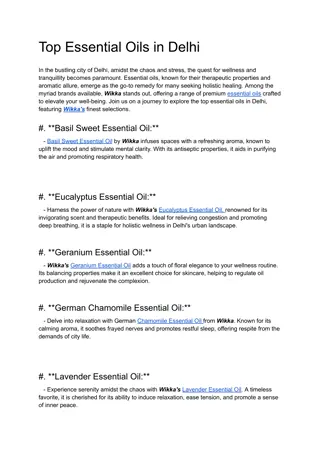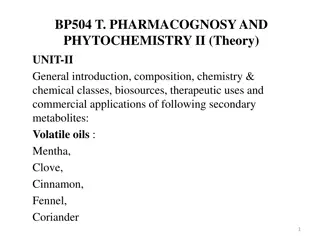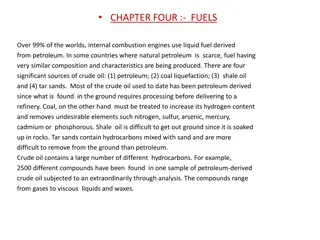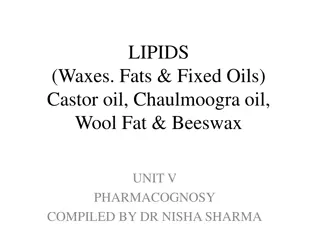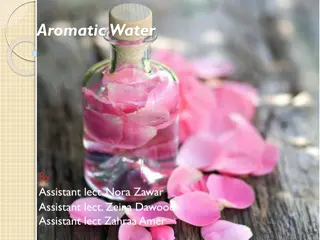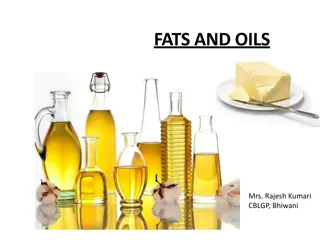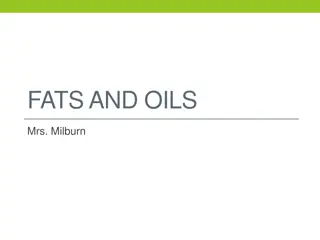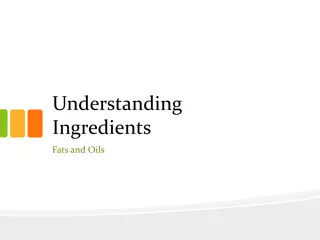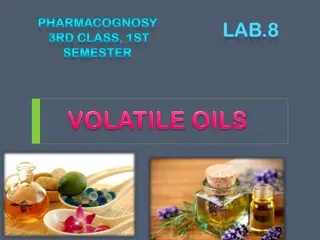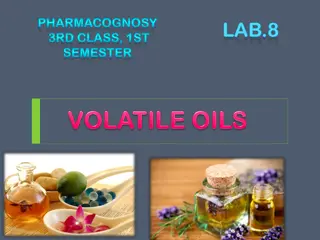
Understanding Essential Oils and Their Characteristics
Explore the world of essential oils, from their origins in plants to their unique characteristics and classification. Discover the composition, properties, and uses of some popular essential oils like eugenol. Delve into the fascinating chemistry behind these aromatic substances.
Download Presentation

Please find below an Image/Link to download the presentation.
The content on the website is provided AS IS for your information and personal use only. It may not be sold, licensed, or shared on other websites without obtaining consent from the author. If you encounter any issues during the download, it is possible that the publisher has removed the file from their server.
You are allowed to download the files provided on this website for personal or commercial use, subject to the condition that they are used lawfully. All files are the property of their respective owners.
The content on the website is provided AS IS for your information and personal use only. It may not be sold, licensed, or shared on other websites without obtaining consent from the author.
E N D
Presentation Transcript
CHEM SEC 204TH CHEMISTRY DEPTT GC PAONTA SAHIB 1
ESSENTIAL OILS CLASSIFICATION OF ESSENTIAL OILS CHARACTERISTICS OF ESSENTIAL OILS THE COMPOSITION, PROPERTIES AND USES OF SOME ESSENTIAL OILS EUGENOL CHEMISTRY DEPTT GC PAONTA SAHIB 2
ESSENTIAL OILS Essential oils are volatile, odoriferous substances obtained from fruits, flowers, leaves and roots of various plants. Plants containing essential oils usually have the greatest concentration at some particular time, for example, jasmine at sunset. Hence, it is better to take the plant parts having essential oils at this particular time. Essential oils in the life of plants are probably connected with metabolism, fertilization or protection from enemies CHEMISTRY DEPTT GC PAONTA SAHIB 3
CHARACTERISTICS OF ESSENTIAL OILS Essential oils are generally insoluble in water but soluble in organic solvents. The oils are volatile with steam and are also volatile enough to distill unchanged in most cases. They vary from colourless to yellow or brown in colour. An essential oil is usually a mixture of compounds (oil of winter green, is almost pure methyl salicylate). They are optically active substances. The refrative index of these oils is high (about 1.5). CHEMISTRY DEPTT GC PAONTA SAHIB 4
CLASSIFICATION OF ESSENTIAL OILS They are generally the mixture of different compounds such as alcohols, aldehydes, esters, acids, ketones, phenols, lactones and hydrocarbons. The compounds occurring in essential oils may be classified as follows: Esters (derivatives of carboxylic acids): Benzoic, acetic, salicylic and cinnamic acids. Alcohols: Linalool, geraniol, citronellol, terpineol, menthol and borneol. Aldehydes: Citral, citraonellal, benzaldehyde, cinnamaldehyde, cuminic aldehyde, vanillin. CHEMISTRY DEPTT GC PAONTA SAHIB 5
Phenols: Eugenol, thymol, carvacrol. Acids: Benzoic, cinnamic, myristic, isovaleric acids. Lactones: Coumarin. Terpenes: Camphene, pinene, lemonene, cedrene, phellandrene. Hydrocarbons: Styrene, cymene. Esters: Cineole, eucalyptole (internal ether), safrole, anethole CHEMISTRY DEPTT GC PAONTA SAHIB 6
THE COMPOSITION, PROPERTIES AND USES OF SOME ESSENTIAL OILS EUGENOL It is a colorless to pale yellow, aromatic (aroma) oily liquid extracted from certain essential oil especially from clove oil, nutmeg, cinnamon, basil or bay leaves. CHEMISTRY DEPTT GC PAONTA SAHIB 7
Chemical Composition: It is an aromatic organic compound which has ether, alcoholic groups in it and a small unsaturated side chain. Natural sources: Eugenol is naturally occurring in several plants. Cloves are one of the richest sources of eugenol.The clove bud oil and clove leaf oil contain 80-90% of eugenol. The plants which are source of eugenol are, worm wood, cinnamon, nutmeg, lemon balm, bay leaf ginger etc. CHEMISTRY DEPTT GC PAONTA SAHIB 8
Uses of Eugenol It is used as a local antiseptic and anaesthetic. It is used in manufacture of perfumes, flavorings and essential oils. Eugenol can be combined with zinc oxide to form zinc oxide eugenol which has restorative and prosthodontic applications in dentistry especially in root canal sealing. It can be used to reduce the presence of Listeria monocytogene and Lactobacilluy salkei in food. It is used in manufacturing stabilizers and antioxidants for plastic and rubber. It is growing popularity as anaesthetic and used on aquarium fish as well as on wild fish when samples are required for research and management CHEMISTRY DEPTT GC PAONTA SAHIB purposes. 9
CHEMISTRY DEPTT GC PAONTA SAHIB 10

